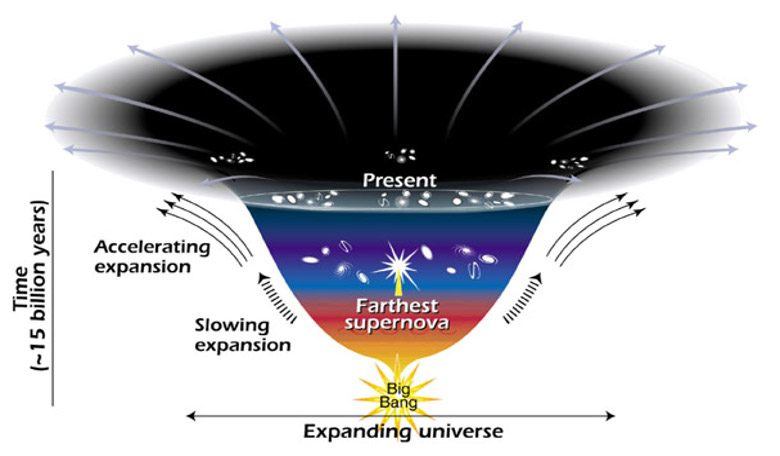It is generally accepted that that the Universe is expanding and that a mysterious dominant substance known as 'dark energy' is responsible for pushing galaxies and the space in-between away from everything else at an accelerating pace. Now however, scientists are casting doubt on this standard cosmological model as new data has become available.
The data relates to studies on a type of exploding star known as a Type 1a supernova. Type 1as involve two stars, one of which is a white dwarf – the one that will explode - and because the white dwarf can only accrete a certain amount of mass before it explodes, its brightness will always be the same. They are therefore referred to by astronomers as ‘standard candles’ and are used to calculate distances in space. Studies on Type 1a supernovae led to the conclusion that the Universe is expanding and for this discovery, the scientists involved won the Nobel Prize in Physics five years ago.
Now, making use of a catalogue of 740 Type Ia supernovae, a vastly increased data set compared with the original sample size, a team of scientists led by Professor Subir Sarkar of Oxford University's Department of Physics have found that the evidence for acceleration may not be as robust as previously thought, and that the data is more consistent with a constant rate of expansion instead.
'The discovery of the accelerating expansion of the universe led to the widespread acceptance of the idea that the universe is dominated by "dark energy" that behaves like a cosmological constant - this is now the "standard model" of cosmology,” said Sarkar. “'However, there now exists a much bigger database of supernovae on which to perform rigorous and detailed statistical analyses. We analysed the latest catalogue of 740 Type Ia supernovae - over ten times bigger than the original samples on which the discovery claim was based - and found that the evidence for accelerated expansion is, at most, what physicists call "3 sigma". This is far short of the "5 sigma" standard required to claim a discovery of fundamental significance.”
It is not just Type 1a supernovae that have been used to infer an accelerating Universe. Information on the cosmic microwave background (CMB) - the faint afterglow of the Big Bang - has also been used to support the same idea. However Professor Sarkar is also apprehensive about the CMB and its role to explain a rapidly expanding Universe. “All of these tests are indirect, carried out in the framework of an assumed model, and the cosmic microwave background is not directly affected by dark energy. Actually, there is indeed a subtle effect, the late-integrated Sachs-Wolfe effect, but this has not been convincingly detected.”
“So it is quite possible that we are being misled and that the apparent manifestation of dark energy is a consequence of analysing the data in an oversimplified theoretical model - one that was in fact constructed in the 1930s, long before there was any real data,” continued Sakar. “A more sophisticated theoretical framework accounting for the observation that the universe is not exactly homogeneous and that its matter content may not behave as an ideal gas - two key assumptions of standard cosmology - may well be able to account for all observations without requiring dark energy. Indeed, vacuum energy is something of which we have absolutely no understanding in fundamental theory.”
What does this mean then for the accepted hypothesis that the Universe is rapidly expanding? Professor Sarkar is quick to note that this research may not overturn current theories overnight and that a lot of work will be necessary to convince the physics community of these new results. “But, our work serves to demonstrate that a key pillar of the standard cosmological model is rather shaky. Hopefully this will motivate better analyses of cosmological data, as well as inspiring theorists to investigate more nuanced cosmological models. Significant progress will be made when the European Extremely Large Telescope makes observations with an ultrasensitive "laser comb" to directly measure over a ten to 15-year period whether the expansion rate is indeed accelerating,” concluded Sarkar.











